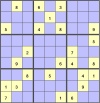Conventions
Menu

Play Sudoku

Fish Database

Bird Database

Plant Database
Introduction
Conventions are a part of the auction, that are extensions of the standard bidding system. They are referred to as "conventions" because unlike with pure biddding, the actual value bid does not indicate the contract that the partnership really desires, but has a special meaning. Some of the conventions are so common, that they are really regarded as a part of standard acol.
There are so many different conventions around we have decided only to document the ones that have been implemented in WolfBridge and are some of the most common ones. Most of the conventions are useful for strong hands when there is a chance of a slam contract.
Much of the auction, including the conventions, has been based on "All About Acol" by Ben Cohen and Rhoda Lederer, which is an excellent book, highly recommended for any beginners to intermediate bridge players.
Trial Bids
Trial bids are used when you open one of a major suit, that is immediately raised to two of that suit by your partner, showing 6-9 points and a match for your suit. If you were to raise to the three level and partner had originally raised on a maximum, then they will bid four of the major no problem, however if they were bidding on less than the maximum number of points, they are likely to then no-bid, even though if they hold 7-8 points and with a good fit in other suits, you are likely to be able to make game. This is where a trial bid comes to the rescue.
After the 1M,2M bidding sequence, if you intend to raise to 3M, hoping that your partner can find the extra strength to put you into 4M and you need help in one of the minor suits (a holding of a few rags in one of the minors), then you can bid 3 of that minor, asking your partner for help in that suit. Your partners responses are then:
- With minimum hand for raise, convert to 3M
- With maximum hand for raise, convert to 4M
- With "help" in trial bid suit convert to 4M else 3M
- If trial bid was in clubs but have help in diamonds, we can declare this by bidding 3 diamonds, leaving partner to decide what to do
"Help" in the trial bid suit is generally to control the suit after no more than two losers. A void, singleton or doubleton plus a four card trump suit is good, or an A or Kx or Qxx are also great help.
Blackwood
Blackwood is a means of determing how many aces and kings your partnership holds, once the trump suit has been established. It is only good if you need to know how many aces or kings your partner holds and are not so concerned about exactly which ones they are, in which case you are better off using "Cue Bidding" (described later).
Since Blackwood is dependent upon a suit contract being established, it is not possible to use this when bidding No Trumps. The "Gerber" convention is a similar sort of device for asking for aces when bidding No Trumps.
The convention is, that once a suit contract has been established, if either of the partners then bids four No Trumps, this is then asking for a count of aces. The responses to this bid are then as follows:
- 5C = None or four aces
- 5D = One ace
- 5H = Two aces
- 5S = Three aces
You might ask how you can work out what 5C means, but in reality, you are very unlikely to have got as far as thinking you have enough points to make a slam if your partnership holds none of the aces, so if you hold none and your partner bids 5C, it's likely that they hold all four.
If you decide that given your holding of aces you're still likely to make a slam, but you still need to know about your partners holding of kings, then then the next bid is the conventional "five No Trump", asking for kings.
The responses to this are as follows:
- 6C = None
- 6D = One king
- 6H = Two kings
- 6S = Three kings
- 6NT = Four kings
Gerber
An immediate response of 4C to partners opening 1NT trump is the "Gerber" convention, asking partner to give a count of aces.
The standard respones to 4C are:
- 4D = None or four aces
- 4H = One ace
- 4S = Two aces
- 4NT = Three aces
A subsequent bid of 5C by the original bidder is then asking for kings and any other bid is a sign off that should be left undisturbed by the opening 1NT bidder.
The standard respones to 5C are:
- 5D = None or four kings
- 5H = One king
- 5S = Two kings
- 5NT = Three kings
Stayman
After a 1NT opener a response of 2C is the "Stayman" convention, asking partner to show a four card major suit if he has one. Openers rebid is then:
- Holding one four card major, bid 2 of that major
- Holding both four majors, bid 2H
- Holding neither major, bid 2D
The responders rebid is then as follows:
- Partner bid a major I like. Pass or raise that suit
- Partners response was not what I wanted. Convert to 2 or 3NT, make a weak take-out bid, or jump-bid own strong suit
- Partner gave a negative 2D, but I'm determined to play in a major if possible. Bid 3D is asking for a 3 card major.
- Bidding 3C indicates that the 2C was not intended as Stayman but a real club bid
Baron
After a 2NT opener a response of 3C is the "Baron" convention, asking partner to show a four suit if he has one. It can also be used after a 2C opener followed by 2D response and a 2NT rebid. The respones to the Baron 3C are:
- 3NT if he only hold a four card club suit
- With one four card suit, bid that suit
- With two four card suits, bid the lower ranking one unless it's clubs
Swiss
A bid of 4C or 4D after an opening of 1H or 1S is the "Swiss" convention. It is used when the hand is strong enough for a direct jump to game of the major, holds two or three aces but is insufficiently strong to make a forcing bid. The bids have the following meanings:
- 4C shows two aces, four card trump support and 13-15 points
- 4D shows three aces, four card trump support and 13-15 points
This is a useful bid, because given the holding of so many aces, it is otherwise unlikely that partner would consider a slam without this bid that tells them how many aces we hold at the same time as promising support of their suit.
Cue Bidding
Cue bidding is used once a trump suit has been established and there is interest in a possible slam contract, but the partnership needs to exchange information about first and second round controls.
Unlike blackwood, cue bidding indicates the suit in which a control is held. It is therefore of greatest use when for example a blackwood response of "one Ace" would not be enough because you need to know which ace. Say for example you hold KQx in one suit and xxx in another suit (outside of your trump suit). If partner holds the A in your suit with KQx, you could still be wide open to attack in the suit with xxx and the contract could go down inside the first couple of tricks, however if your partner holds the ace in the suit with xxx, then you still have a chance for a small slam.
Once the trump suit has been established, a bid of another suit is a cue bid, showing first round control in that suit and suggests that you're inerested in a slam. The responder can then cue bid their own first round controls in order. Missing out a suit indicates that no first round control is held in that suit.
Note that if the responder had responded with a minimal holding, then they should avoid cue bidding if it takes the contract beyond game.
Grand Slam Force
Described here is actually the modified Grand Slam Force. The "Grand Slam Force" is a way of asking partner how many of the top three trumps they hold. It is bid by jumping straight to five No Trump without having bid a Blackwood four No Trump. The responses are as follows:
- With 2 or 3 of the top three trumps bid 7 of the agreed suit
- With 1 of the top three trumps bid 6 of the agreed suit
- With 0 of the top three trumps bid 6C
The convention "Josephine" in WolfBridge, is basically the Grand Slam Force after Blackwood. If instead of the Blackwood bidder reverting to five No Trump to ask for aces, or backing off into a suit at the five level, if they bid six clubs, then they are asking for the top trumps as above.
Further reading
Some useful tips can be found at the following web sites:
